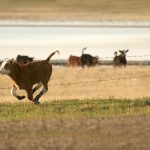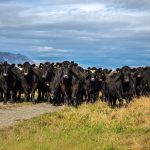Although that lush green grass seems appealing, there are hidden concerns that producers need to remember when turning out their cows.
The snow might be flying throughout much of the country, but it won’t be long before cattle producers are thinking about turning pairs out to pasture. Although that lush green grass seems appealing, there are hidden concerns that producers need to remember when turning out their cows.
One of those concerns is grass tetany. Kevin Glaubius, Director of Nutrition at BioZyme® Inc., took time to answer a few questions about grass tetany to help producers prepare for spring and early summer grazing.
1. What is grass tetany? How is it caused and what are the symptoms?
Grass tetany is also called grass staggers because when cattle become susceptible they start to stagger around and will go down on their side. One of the first symptoms is general lack of coordination.
Most producers think of tetany as a magnesium deficiency, because feed companies use magnesium to prevent occurrence, but really it is excessive intake of potassium. Potassium and magnesium compete for the same absorption pathway. Think of it like a funnel where three potassium marbles are trying to get through the funnel the same time as one magnesium marble. Since the percentage of potassium marbles is greater, that nutrient is more likely to go down the funnel and get absorbed before the magnesium does.
Tetany typically occurs in older animals rather than younger animals because of an inability to mobilize the magnesium from the bones. Mature cows will show signs long before a young calf.
2. Is there a time of year it is most prevalent? Is grass tetany found in every region or does it confine itself to one geographic area?
Most of the time tetany will happen when cattle are on lush forages. While transitioning from winter to spring, nutrients, including potassium, are being pumped up from ground through the roots to support plant growth. When we have a few weeks of warm weather, those nutrients get pumped up to the plant that is above ground, actively growing. But if a cold snap or cool weather sets in, growth pauses but those nutrients remain in the plant. With those warm weather/cold weather cycles, the potassium levels can potentially become twice the amount they normally are, leading to tetany challenges when you turn your cows out around May 1.
Since tetany is a nutritional issue, it isn’t isolated to just the spring and summer when we turn cattle out to grass; It can also happen while feeding hay. In that case, we have what might be referred to as “winter tetany” or “wheat pasture poisoning” when cattle are fed harvested winter feeds that are high in potassium.
Most of the country doesn’t have problems with it in the fall. However, it can be an issue especially if producers fall fertilize.
Tetany is a global issue and impacts all ruminants who have an improper potassium:magnesium ratio.
3. What are the best ways to prevent grass tetany?
There is no perfect mineral for preventing grass tetany. If you have extremely high potassium level, it is important to realize that a higher percentage of magnesium doesn’t always mean it is better. Magnesium isn’t palatable, and cows will likely walk away from straight magnesium or minerals with slightly higher levels of magnesium.
Start increasing magnesium levels about two weeks before turning out to pasture so you can gauge how much the cow might eat when she is turned out on grass. Remove all other sources of salt so that forces the cows to get salt from the mineral if the bitterness of higher magnesium restricts intake to less than the restricted amounts.
Feeding a high mag mineral during the high-risk periods such as spring and fall when the growing season can easily be disrupted will prevent the vast majority of issues.
4. If an animal is diagnosed with grass tetany, how is it best treated?
Remember to check your cattle regularly when they are first turned out to new, green grass. Grass tetany is treatable if it is caught early enough. Call your veterinarian at the first signs of any tetany. The vet will typically provide an intravenous solution of calcium, magnesium and glucose to get the cow back on her feet. Timing is critical, though as cows will likely die if not treated within 4-8 hours after onset.
The key to preventing tetany is to provide the proper amounts of all nutrients, Glaubius said. If you can keep your magnesium to potassium ratio in check, your cows should enjoy grazing green grass and keep healthy. BioZyme offers several supplements in its VitaFerm® product line that are enhanced with magnesium to help prevent the onset of tetany including VitaFerm Concept•Aid® Mag/S. and VitaFerm Cow-Calf Mag Mineral. To learn more about these and other VitaFerm Products, visit: http://vitaferm.com.


